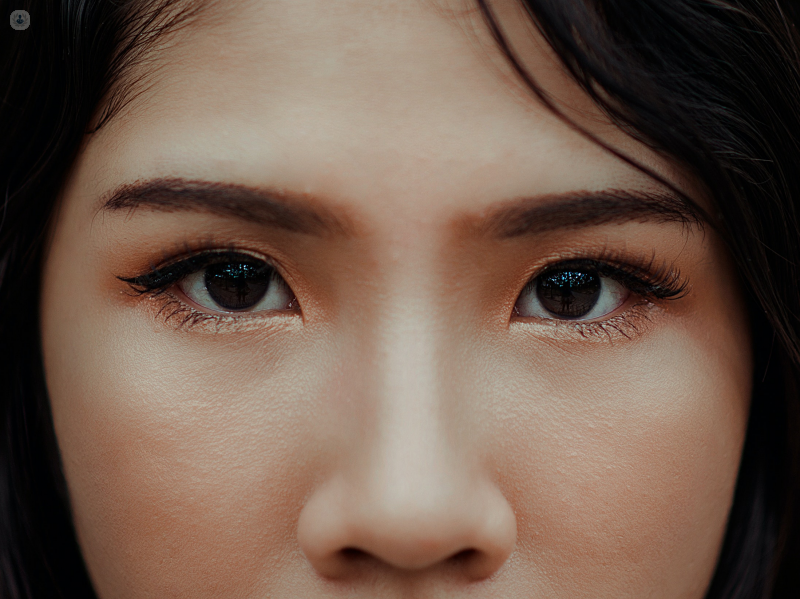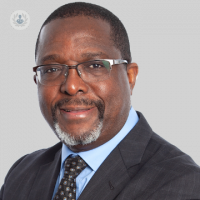Rhinoplasty: what are the risks and what happens if I’m not satisfied with my new nose?
Written by:As in any surgery, there are benefits, risks and the final results are not always guaranteed. It is important to note that rhinoplasty is an elective operation and you do not need to have it; no surgery can also be a good option for some patients. Whilst severe complications are rare, rhinoplasty surgery has well-described downsides and you must be aware of them before electing to undergo the operation.
In this article, Professor Charles Malata lists the main risks and complications involved with a rhinoplasty procedure and explores the options you have if you don't like the look of your new nose.

Bruising and swelling
After a rhinoplasty or septorhinoplasty, swelling and bruising of the nose and around the eyes and the cheeks is very common and cannot be avoided. This can be alarming to look at, particularly if any of your nasal bones were broken during surgery, as it usually results in black “panda eyes”. Subconjunctival haemorrhage may appear too, which is when there is bruising in the whites of the eyes, however, this usually resolves after a few weeks. Applying ice-cold compresses to the cheeks and forehead can help to reduce the swelling and bruising.
In the medium-term, tissue swelling, especially in the nose tip, is very common. This is known as oedema or tissue fluid in the skin and subcutaneous tissues of the nose. The thicker the skin, the longer the oedema will last. In general open rhinoplasty is also associated with slightly more prolonged tissue swelling than closed rhinoplasty.
Bleeding
Significant bleeding after a rhinoplasty or septorhinoplasty is uncommon. However, oozing from the nose after removal of the internal splints for a few days is common. You should try to avoid knocking your nose or blowing it too hard as this can lead to more bleeding. Severe bleeding that requires hospital readmission for observation, fluid replacement or drainage, or even a reoperation, is very uncommon and occurs in less than 3% of cases.
If you or a close relative are prone to bleeding or have any type of bleeding disorder such as haemophilia, von Willebrand’s disease or any other, then you must inform me during your consultations prior to the operation so that I can assess your risk and put in place any necessary measures prior to the operation such as replacement clotting factors, platelets, counteracting drugs (DDVAP, tranexamic acid), blood cross match, haematology consultation, etc.
Infection
An infection after rhinoplasty surgery is very rare (2% of cases). It may manifest as a pus-like discharge from the nose, swelling and redness. It may also cause sinusitis (swelling of the sinuses) or infection of the grafts used to reshape your nose. Any infection must be treated promptly as, if left untreated, it can cause further health problems. During surgery, you will be given intravenous antibiotics which will continue overnight. You will also be given preventive oral antibiotics to take at home which you must complete.
Airway problems
Soon after the operation, it is relatively common to experience airway obstruction, and it’s often due to swelling, any nasal packs and internal nasal splints. This initial difficulty in breathing through the nose largely subsides a few weeks after surgery. If, however, you find it is persistent and do not notice an improvement, the airway obstruction may be caused by the following:
- An undiagnosed enlargement of the turbinates (the cushions inside your nose which warm and moisturize the air as we breathe in)
- An overlooked septal deviation
- A collapse of the internal nasal valves or,
- Excessive narrowing of the bridge of the nose
Should your airway problems persist, please get in contact with me so that I can determine the root of the problem and what treatment, if any, is required.
Impairment of your sense of smell
Temporary loss of smell usually happens and can be distressing for some people if they don’t know to expect it. Due to this loss of smell, you may experience an additional loss of taste. Both these sensory impairments tend to settle down with time as the swelling of the internal lining (mucosa) of the nose subsides.
Minor irregularities
Small irregularities of the nose are common after surgery. The thinner the patient’s skin is, the easier it is for you to notice bumps or lumps across the nose. Although these are normally transient, sometimes they may need future rasping (“smoothing down” the contour) in theater under local or general anaesthetic. If the irregularity doesn’t bother you or is not visible, then it does not require treatment. I always take time to smooth out any irregularities during the operation but the thickness of the skin on your nose cannot be changed.
Inadequate straightening of a crooked nose
Sometimes the nose isn’t always completely straightened out after surgery, due to the memory in the tissues. It is important to appreciate that the surgery aims to improve a bent or crooked nose and this cannot be expected to lead to a millimetre-perfect result.
Perforation of the septum
This is rare, but it manifests as a whistling or drying out of the inside of the nose. It does not require treatment unless it causes you problems. It can lead to crusting of the nose and maybe even minor bleeding of a fragile mucosa (internal lining). Noisy breathing at night or whistling usually implies a small perforation which opens up intermittently.
Corneal abrasions
These are extremely rare and result from inadvertent scratching of the eyes while you are asleep or when waking up from anaesthesia. We protect your eyes from this during surgery using an antibiotic ointment and/ or transparent plastic dressing. Symptoms include pain and watering in one eye and are treated by washing it out with sterile saline solution followed by applying ointment and wearing an eye patch overnight.
Residual asymmetry
While it doesn’t happen very often, mild asymmetry can be inevitable. Please remember that rhinoplasty and septorhinoplasty aim to improve the appearance and function of your nose - not to achieve perfection. If there is severe asymmetry, however, further procedures such as surgery or fillers will be offered to you.
Scars
- Columellar scarring
Occasionally, the scar on the partition between the two nostrils can end up uneven, depressed, thick or hyperpigmented. Revising this is uncommon as simple measures such as massaging and/or steroid injections often help to resolve this.
- Vestibular scarring
There may also be troublesome scarring on the internal lining of the nose. If this occurs, it is usually in patients who have had surgery on their turbinates (turbinectomy) or on their septum either to correct a deviated septum (the central partition of the nose) or more commonly to harvest some cartilage from it for use to refine the nasal tip or dorsum. It manifests as contractures, webs, blockage (stenosis) or bands across the lining of the nose (synechia). These may rarely need division or stenting.
Psychological problems
These have been reported in patients who have undergone nose jobs. Undergoing a rhinoplasty or septorhinoplasty can exacerbate underlying psychological or psychiatric problems. It is crucial that you are honest and transparent about your medical history (psychological and otherwise) and inform me about all the prescriptive and non-prescriptive medication you are taking, in addition to your support at home and work. If you or I have any concerns, I can refer you to see my psychologist for evaluation and support either before or after the rhinoplasty operation.
Sometimes, patients cannot handle the appearance of their new nose and change their mind. I often find that the more mature the patient is (this does not always correlate with age), the more likely they will be happy with their new nose and experience less psychological problems after. If you are a teenager, I recommend you attend the consultations with your parents, and the same goes for couples; it is often better to come with your partner for support. I do not operate on anyone who is under 18 years of age as the nose is still growing and changing. Additionally, teenagers often change their minds about whether they want surgery or not.
What happens if I am not satisfied with the result?
As with all cosmetic surgery, the final results are not guaranteed. Some reasons why you may not be totally satisfied with your new nose and look for revision surgery include:
- Inadequate reduction
- Tip asymmetry
- Minor irregularities
- Persistent crookedness
- Airway problems
- Residual hump
- Saddle nose deformity
- Change of mind
As the nose is in such a prominent position on the face, it is not surprising that of all the cosmetic operations performed, rhinoplasty and septorhinoplasty have the highest risk of revisional surgery. It is relatively common for a patient to seek another surgery and happens in around 10-20% of cases. A nose job is often described by many surgeons as a two-stage process and I frequently revise rhinoplasties performed by other surgeons from up and down the country.
You must be fully aware of this before surgery as having another operation requires more time off work and additional costs. Revision surgery is never carried out straight away; we often wait 9-12 months because most of the minor “nuisances” tend to settle down with time.
Following surgery, I advise patients to massage the nose to assist with the healing process and reduce the visibility of scars. It is more difficult to correct any problems with the nose earlier than 9-12 months as the surgical planes of dissection may be obscured by swelling and scarring. Sometimes, injection of steroids into thickened areas of the nose can help particularly if scarred tissues internally persist, which usually occurs in the tip or supratip areas of the nose. Care is, however, exercised to avoid overdoing this and causing a depression or loss of skin pigment. Revision surgery can be undertaken under local anaesthesia and sedation or a general anaesthetic.
Professor Charles Malata is a leading consultant plastic surgeon based in Cambridge and Peterborough. To book a consultation with him, visit his Top Doctors profile and check his availability.


